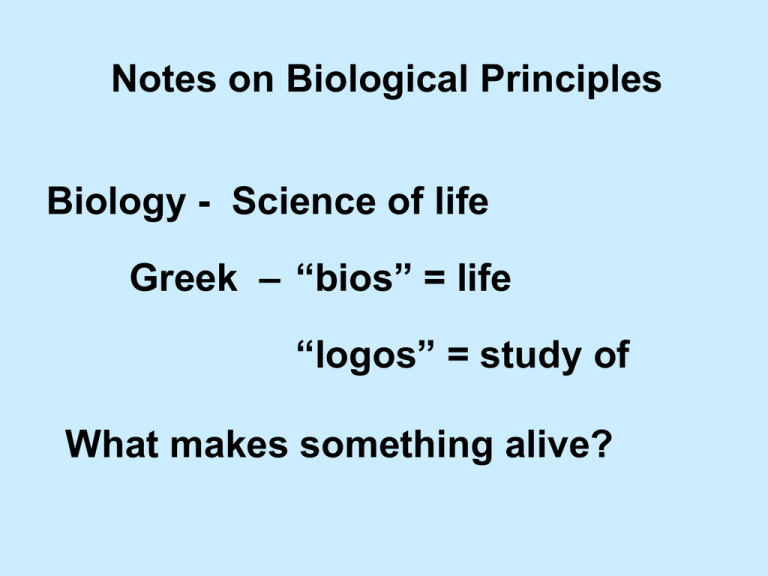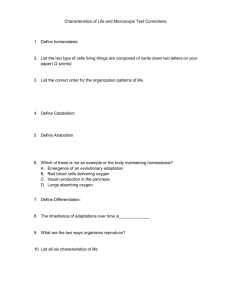Notes on Biological Principles Biology
advertisement

Notes on Biological Principles Biology - Science of life Greek – “bios” = life “logos” = study of What makes something alive? “old school” Biology / Botany (study of plants) \ Zoology (study of animals) More Divisions of Biology Note: asterisks = divisions we will study in this class Microbiology – study of microorganisms *Genetics – study of heredity *Ecology – study of the interactions of living organisms and their environment *Evolution – study of change in populations over multiple generations *Taxonomy – study & organization of biodiversity *Cytology – study of cells Nine Life Activities that occur in all living things: 1. Nutrition – getting food 2. Digestion – chemical changing of food into a form that is useable 3. Absorption – getting water, ions, and/or food from the environment 4. Biosynthesis (assimilation) – using food and absorbed materials to make new life substances Living things grow and develop 5. Respiration – process by which food is oxidized to release and repackage energy 6. Excretion – separation of waste products (from metabolism) from the organism 7. Secretion – manufacturing of special chemicals (hormones and vitamins) which affect other cells 8. Response – change due to stimuli from environment (ex: heat, light, or pressure) • another term for response irritability • example of irritability locomotion 9. Reproduction – cells dividing to produce new cells/ individuals Can be asexual or sexual Governed by a universal genetic code Levels of organization in living organisms: A. Protoplasm: The organized chemicals and chemical activity in any living thing(s) that make life possible Metabolism – the sum total of all chemical reactions which build up and tear down complex molecules Protoplasm is where metabolism happens! Protoplasm is life Only living organisms organize protoplasm – “stuff of life” • Life activities occur in protoplasm • Homeostasis is maintained by and for the protoplasm • Dogs pant • We produce insulin to lower blood sugar • We breathe out CO2 and take in O2 • All life activities involve energy B. Cells nucleus cytoplasm cell membrane Organisms can be unicellular or multicellular. C. Tissues – cells that are alike in structure and function 4 types of human tissues: nervous muscular epithelial connective Add their functions to your notes D. Organs – several tissues working together as a unit E. Organ Systems – 11 Human Body Systems & their basic functions 1. Digestive - nutrition 2. Reproductive – production of a new individual 3. Excretory – filters blood, removes wastes 4. Endocrine – regulates body, functions by hormones 5. Skeletal – body support & protection of organs 6. Muscular - movement 7. Circulatory – transportation of food, wastes & other solutes 8. Nervous – sends and receives messages to control and coordinate the body 9. Respiratory – takes in O2 and removes CO2 10. Integumentary – protection (example – skin) 11. Immune – protects against and fights disease F. Organism Levels of Organization Organism Individual living thing Groups of Cells Bison Tissues, organs, and organ systems Nervous tissue Brain Nervous system Smallest functional Cells unit of life Nerve cell Groups of atoms; Molecules smallest unit of most chemical (Smallest) compounds Water DNA Levels of Organization (Largest) *J. Biomes & Biosphere The part of Earth that contains all ecosystems *I. Ecosystem Community and its nonliving surroundings Biosphere Hawk, snake, bison, prairie dog, grass, stream, rocks, air *H. Community *G. Population Populations that live together in a defined area Group of organisms of one type that live in the same area Hawk, snake, bison, prairie dog, grass Bison herd Review of Measurement Science uses metric measurement Base units: weight = gram measurement of liquid = liter measurement of length = meter Abbreviations k h da Prefix Kilo hecto deka Meaning 1000 100 10 Practice Problems: 900 1) 90 cm= __________mm 6 2) 60 mL= __________ cL .0122 3) 12.2mg= _________ g 602000 4) 602 m= __________mm 510 5) 0.51L= __________ mL g,l,m base 1 d c deci centi .1 .01 m milli .001 A correct measurement will have exact numbers and one final estimated digit; The number of digits in a correct measurement depends on the tool being used. Answer: 41.63 cm 416.3 mm 0.4163 m Answer: 373.32 g Answer: 52.7 mL Notes on Scientific Method Goal of Science – investigate and understand nature • Science is an organized use of evidence to learn about the natural world • Science starts with observations – information gathered using the senses (data) 2 forms for gathering information 1. Quantitative – uses numbers (counting and measuring) 2. Qualitative – uses the senses inferences – interpretation based on what you already know Scientific Method – a logical, organized method of study (used to establish scientific principles) 5 Steps to the Scientific Method 1. State the problem Hmmm? State the Problem State the Problem What question will your experiment answer? 2. Make an educated guess, hypothesis, about the answer based on what is known about the problem Known Hypothesize Hypothesis It is written as an “if” “then” statement Ex: If we turn the heat up on the stove, then the water will boil. 3. Design and conduct an experiment to test the hypothesis Experiment Controlled Experiments – must have 2 groups a. control – under normal conditions, key factor is not allowed to change b. Experimental – exposed to a variable 4. Analyze the data collected during the experiment Collect and Record Data Analyze the data collected during the experiment What did the experiment show you? 5. State the conclusion Ah Ha! Come to a Conclusion After much testing if the hypothesis explains how – it becomes a scientific principle When a hypothesis explains why – it becomes a theory Notes on the Microscope Magnification – the power to increase an object’s apparent size Resolution – the power to show detail clearly Light microscope – uses light Specimen – is the object being viewed Must be thin enough to let light through Magnifying glass – simple microscope Compound light microscope – 2 kinds of lenses 1. Ocular – (eyepiece 10x) 2. Objective lens – (near the specimen) Degree of magnification – determined by the lenses x – stands for times Total magnification – multiply the power of the objective by the power of the ocular x Objective *Scan *Low *High *Oil Immersion Power of Ocular objective Total Magnification 4 10 40 10 10 100 40 10 400 100 10 1000 * objectives used in this class How do you increase magnification? Use a 20x ocular • 2000x is usually as high a magnification as can be obtained with a compound microscope Why is 2000x the limit for a compound microscope? Above 2000x – decreased resolution • magnification is no good if clarity (resolution) is lost Above 2000x - you must have an electron microscope Dissecting Microscope ocular arm coarse adjustment fine adjustment light source base stage diaphragm stage clips low power objective high power objective Scan objective revolving nosepiece





